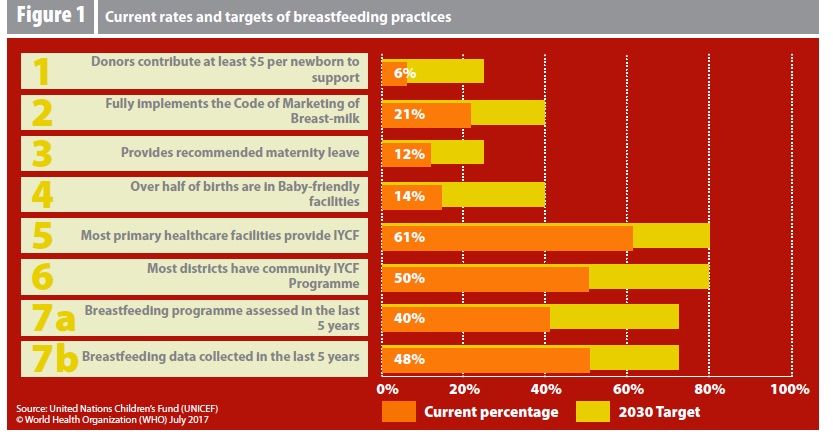Tracking progress for breastfeeding policies and programmes
Breastfeeding (BF) is reported to be one of the most effective investments a country can make in nutrition programming. It not only provides protection against child morbidity (e.g. from diarrhoea and respiratory infections), it is also associated with increased intelligence in children, thereby enhancing human capital (Victora et al, 2016). It also brings benefits to mothers, including prevention of breast and ovarian cancer and diabetes. And new evidence confirms that the practice reduces the risk of non-communicable diseases and decreases the prevalence of overweight and/or obesity later in life (Victora et al, 2016). Yet recent economic analysis estimates that present low levels of BF at six months of age could account for a global loss of gross national income (GNI) of US$302 billion annually (0.5 per cent of GNI) (Rollins et al, 2016).

The Global Breastfeeding Scorecard (2017) is produced by a WHO-UNICEF-led collective of over 20 organisations which analyses a wide range of indicators that can influence breastfeeding. These include:
- Funding for the creation and maintenance of programmes that support infants, mothers and health workers;
- Regulation of the marketing of breast-milk substitutes;
- Paid maternity leave;
- Ten steps to successful breastfeeding (baby-friendly hospital initiative);
- Counselling;
- Community support programmes;
- National assessment of BF policies and practices; and
- National monitoring of BF rates.
Every mother decides how to feed her child, but her decision is strongly influenced by economic, environmental, social and political drivers.
Worldwide, performance on recommended policies and programmes for breastfeeding is poor. In fact, only six countries out of 129 with available data were classified as achieving a recommended performance level in more than half of the indicators. In recognition of this, the collective has set targets for 2030 to galvanise action by policy makers (see Figure 1).
The Scorecard shows that countries with investment in BF protection, promotion and support are able to maintain high rates, with a significant correlation between donor funding and BF rates. It is estimated that each additional dollar spent in donor funding per birth correlates with an average increase of 2.9 percentage points in the rates of exclusive BF at six months; and rates of continued BF at one year increase by 3.3 percentage points for every additional dollar spent. Governments also need to invest more in BF to meet national commitments.
For more information and for country scorecards, visit www.who.int/nutrition/publications/infantfeeding/global-bf-scorecard-2017/en/
References
Victora et al, 2016. Victora CG, Bahl R, Barros AJ, França GV, Horton S, Krasevec J, Murch S, Sankar MJ, Walker N, Rollins NC (2016). Breastfeeding in the 21st century: epidemiology, mechanisms, and lifelong effect. The Lancet, 387(10017), 475–490. http://doi.org/10.1016/S0140-6736(15)01024-7
Rollins et al, 2016. Rollins NC, Bhandari N, Hajeebhoy N, Horton S, Lutter CK, Martines JC, Piwoz EG, Richter LM, Victora CG (2016). Why invest, and what it will take to improve breastfeeding practices? The Lancet, 387(10017), 491–504. http://doi.org/10.1016/S0

